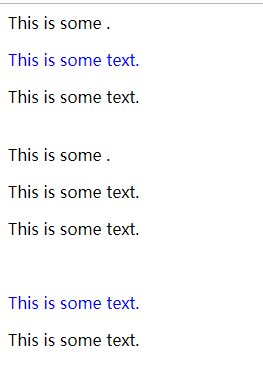nth-child与nth-of-type
nth-of-type这个CSS3伪类还从来没有用过,今天好好研究一番,发现还是有用的。现在下面的Demo
<!DOCTYPE html> <html> <head> <meta charset="utf-8"> <title>test</title> <style> .test1 p:nth-of-type(1) { color: blue; } .test2 p:nth-child(1), .test3 p:nth-child(1) { color: blue; } </style> </head> <body> <div class="test1"> <a>This is some .</a> <p>This is some text.</p> <p>This is some text.</p> </div> <br> <div class="test2"> <a>This is some .</a> <p>This is some text.</p> <p>This is some text.</p> </div> <br> <div class="test3"> <p>This is some text.</p> <p>This is some text.</p> </div> </body> </html>
显示结果如下

可见,p:nth-of-type(1)是取父元素下的p这种类型的第一个,p前面可能会有其它类型的元素;而p:nth-child(1)是父元素的第一个元素,且该元素必须是p。可以参考这篇文章,CSS3 选择器——伪类选择器 但这篇文章有些方向错误,认为nth-of-type在工作中没用。其实在某些情况下还是十分有用的。


